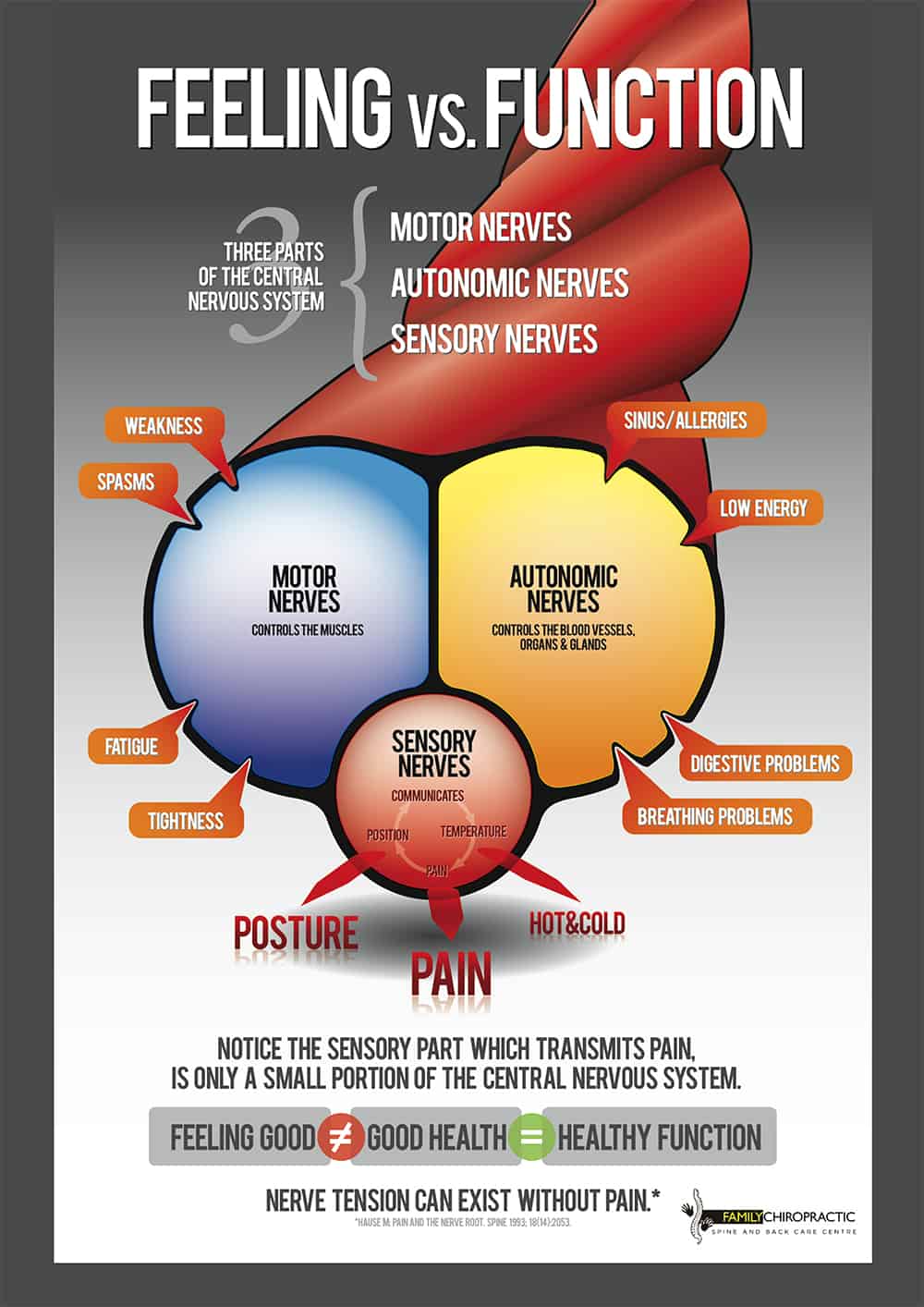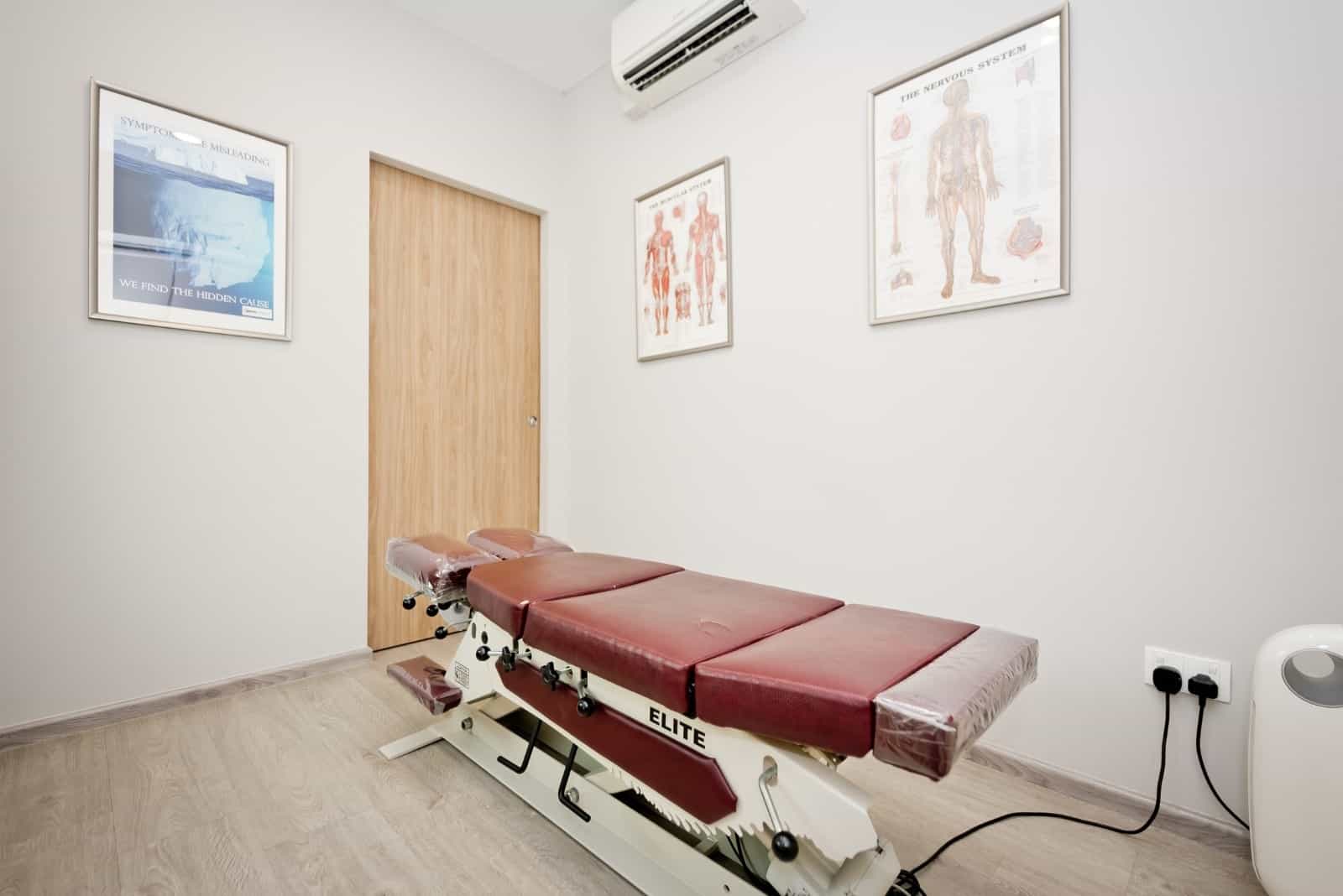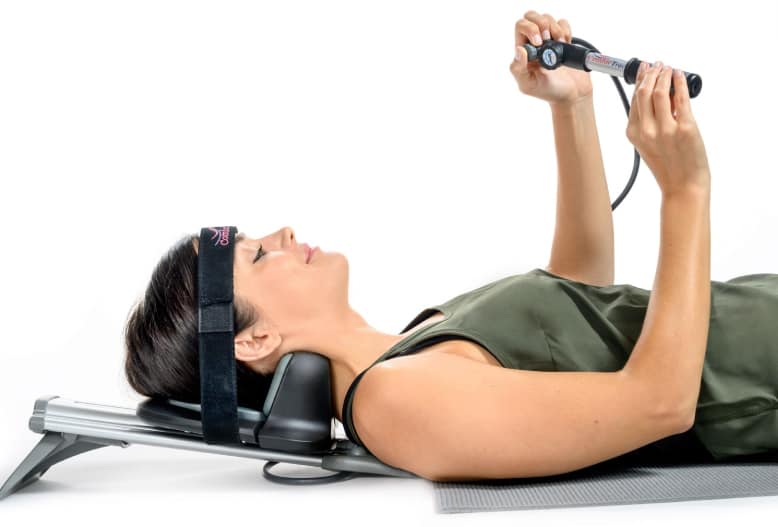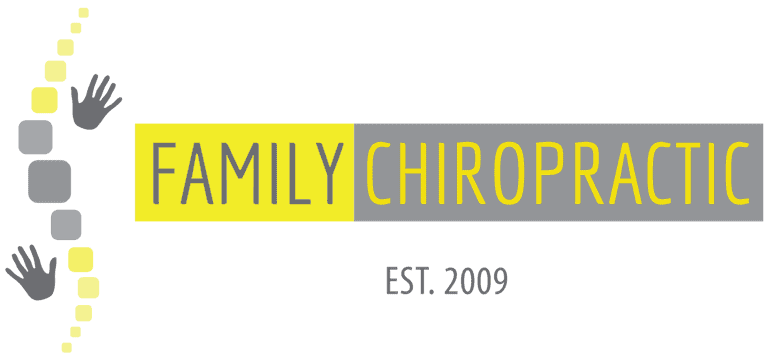What is Chiropractic?
Chiropractic is a healthcare discipline that focuses on the relationship between the spine and the nervous system, and how this affects the maintenance and restoration of your health. It aids your nervous system by removing any nerve compression and irritation that can be caused by stress, thus reviving the body’s innate ability to heal itself.
Chiropractic treatment is safe and suitable for everyone including newborn babies, the elderly, pregnant women and sports enthusiasts. In addition, contrary to popular belief, not all chiropractic treatments involve getting your back ‘cracked’. Apart from spinal adjustment, chiropractic care comprises various ways to manage and treat a condition.
For example, newborn babies may receive gentle craniosacral therapy, elderly and pregnant patients may undergo more delicate treatments, while sports injury cases can be treated with taping, mobilization and physiotherapy modalities.
The journey to recovery also encompasses regular exercise and lifestyle changes to help maintain your health.
Be it mainstream medicine, surgery or alternative healthcare, all treatments involve a certain level of risk. Hence, proper and thorough examination of patients on their first visit is crucial before any treatment is carried out. Your chiropractor may conduct assessments to evaluate if you are suitable for chiropractic care.
Chiropractic has a long history and is an internationally recognised profession that is registered with WHO (World Health Organisation).
Although there have been reported instances of unpleasant experiences with chiropractors, these are typically outlier cases exaggerated by the media with juicy headlines to create unnecessary fear by spreading misinformation without providing any further context.
Before chiropractors can practice in Singapore, their degrees and qualifications are vetted by MOH. However, the profession itself is not being regulated by MOH.
Chiropractors are required to complete their registration in the country they graduate from before they can obtain a proper license to practice in professional organisations within the same country.
Chiropractors may be termed as doctors due to the title of their educational degree (Doctor of Chiropractic) conferred by the American Chiropractic Institution.
However, unlike general practitioners and specialty doctors, chiropractors do not prescribe drugs or perform any type of surgery.
Is Chiropractic proven
to be effective?
Medical doctors can be traditionally wary of spinal manipulation (applying pressure on the bones and joints) for two reasons. Firstly, they do not consider chiropractors as doctors; and secondly, a small handful of chiropractors have falsely claimed that they can use spinal manipulation to address conditions that have little to do with the spine.
However, in 2017, the American College of Physicians released revised clinical practice guidelines for non-invasive treatment of acute back pain—which recommend patients to try heat, massage, acupuncture or spinal manipulation as first-line therapies.
In this guide, we have compiled a credible list of scholarly reviews and studies done in recent years regarding chiropractic treatment.
Chiropractic is effective to reduce pain and improve functions for people with chronic low-back pain.
A 2018 review published in The Spine Journal references numerous studies spanning 17 years which involve spinal manipulation and mobilisation. The review found evidence from a study of 1,176 patients that chiropractic methods are likely to reduce pain and improve function for patients with chronic lower back pain. These results are supported by another study published by JAMA Network which suggests that spinal manipulative therapy helps in reducing acute lower back pain.
Chiropractic treatments and exercises can be more effective to reduce neck pain as compared to over-the-counter medication.
In a 2012 study funded by NIH’s National Center for Complementary and Alternative Medicine, test results indicated that spinal manipulative therapy from chiropractors could be more effective than over-the-counter pain medication for helping with mechanical neck pain. The study involved 272 participants who were divided into three groups that received either spinal manipulative therapy (SMT) from chiropractors, over-the-counter pain medication or exercise recommendations. After 12 weeks, about 57 percent of those who received chiropractic care and 48 percent who exercised reported at least a 75 percent reduction in pain, compared to 33 percent of the people in the medication group. After one year, approximately 53 percent of the drug-free groups continued to report at least a 75 percent reduction in pain; compared to just 38 percent pain reduction among those who took medication.
Chiropractic care can augment standard mainstream medical care to provide better pain relief.
A 2013 study published by Spine Journal shows that, combined with chiropractic manipulative therapy, mainstream medical care could offer a significant advantage for decreasing pain and improving function (as compared to medical care alone) for patients aged 18 to 35 years with acute low back pain.
Patients in the U.S. found chiropractic care to be effective in treating back and neck pain as well as improving their overall well-being.
Patient satisfaction is an important and commonly used indicator for measuring the quality of healthcare, since it affects clinical outcomes, patient retention and medical malpractice claims. Researchers analysing the prevalence, patterns and predictors of chiropractic utilisation in the U.S. general population found that back and neck pain were the most prevalent health problems for chiropractic consultations, and the majority of users reported chiropractic helping a great deal with their pain issues and improving their overall health or wellbeing.
How does
Chiropractic work?
Theoretically speaking, the proper alignment of the body’s musculoskeletal structure, particularly the spine, enables the body to heal itself without surgery or medication. Hence, chiropractors often use a hands-on spinal manipulation approach and other alternative treatments.
Manipulation is used to restore mobility to joints restricted by tissue injury. These injuries can be caused by traumatic events such as falling, or repetitive physical stress such as sitting without proper back support.
Chiropractic treatment is primarily used as a pain relief alternative for muscles, joints, bones and connective tissue, such as cartilage, ligaments, and tendons. It is sometimes used in conjunction with conventional medical treatment.


What is Subluxation?
A familiar term in modern chiropractic care, subluxation describes a joint that doesn’t work the way it’s supposed to. This could refer to a misaligned joint, or a joint not being able to move how it should. Subluxation can lead to numbness, tingling, pain and a burning sensation in affected areas of the body.
A common area that tends to subluxate is the vertebrae of the spine (spinal subluxation). However, it is important to note that chiropractic treatment does not only relieve spinal subluxation—people suffering from other types of subluxations in other joints can also find relief in chiropractic treatment. Feet, shoulders, ribs, wrists and more can subluxate and be adjusted by a chiropractor.
Contrary to popular belief, chiropractic care involves more than just spinal manipulation. Chiropractors use a variety of treatments to help the body heal itself for a pain-free and healthy life.
Chiropractors may also advise you on your lifestyle choices to help you identify unhealthy habits and provide you with practical strategies to deal with them.
Typical questions may revolve around your occupation type, lifestyle and exercise habits. This allows for chiropractors to give you ergonomic tips on how to improve your posture, footwear, diet and more.
Your chiropractor should be well informed about your medical history, including ongoing medical conditions, current medications, surgical history and lifestyle factors.
Although rare, there have been cases where chiropractic treatment had worsened a herniated or slipped disc, or neck manipulation resulted in a spinal cord injury. For your own safety, always check with your medical doctor to make sure that your condition can benefit from chiropractic or other pain relief alternatives.
Chiropractors may employ a multi-modal approach to provide comprehensive care and ensure long-term health benefits rather than short-term pain relief.
There are 3 main types of approaches offered by different chiropractors in Singapore:
- Symptom care: Focuses only on areas you experience pain. You may be sent for x-ray assessments.
- Wellness care: Focuses heavily on spinal alignment to improve the curvature of your spine. You will typically need to go for x-rays of your spine every few months to track your improvement.
- Comprehensive care: Focuses on both pain areas and spinal alignment. The chiropractor will aim to relieve your current pain areas before focusing on your spinal alignment. Thereafter, further post-treatment care may be included to improve your condition in the long run.
While x-rays are not medically necessary for most chiropractic patients, chiropractors may request for x-ray results to rule out certain red flags, so that they can refer you to a suitable medical practitioner if needed.
X-rays can be used to diagnose several conditions such as:
- A recent trauma which may have resulted in a fracture at any age.
- A minor trauma for those between ages 50 and 70 years old.
- Those over age 70 who are at risk of osteoporosis-related fractures.
- Certain conditions that may be causing spinal degeneration.
- A spinal deformity that might be progressing, such as kyphosis or scoliosis.
In any of the above cases, an x-ray would likely provide critical information that will direct treatment protocols for chiropractors or referral options for the patient.
Different Types of Chiropractic Treatments
Chiropractic treatment sessions generally last around 10 to 15 minutes per session. In more serious cases, these sessions may be
extended depending on your body’s condition and needs.

Manual Treatments
Typically involving adjustments, soft tissue and myofascial therapy.

Instrument-Led Treatments
Some of these techniques include the Activator, Spinal traction devices and Sacral Occipital Technique (SOT) blocks.

Chiropractic Therapies
ultrasound and electrotherapy, sports taping support.

Nutrition & Exercise
anti-inflammatory dietary counselling and functional movement exercises.
Manual Treatments
Spinal manipulation is the most basic and readily available treatment method for chiropractors. It involves a controlled and quick thrust and adjustment. Chiropractors specialize in the spine and fully understand the relationship between the spine and your nervous system, and how that can lead to various pain symptoms and conditions.
Once your spinal adjustment has been completed, your overall alignment will be enhanced along with many of your joints. The goal is to allow each joint to return to its natural range of motion. This is done manually (occasionally with your chiropractor using their weight as assistance) and can help your upper back, lower back, neck, and the joints in your arms and legs.This primary technique is also referred to as the diversified technique. Other forms of spinal manipulation include:
Gonstead Technique: The Gonstead technique applies the same force and quickness of a typical spinal adjustment, but the chiropractor will identify a particular joint that needs to be focused on. This treatment often requires special positioning. Chiropractors that apply Gonstead technique typically have certain tables and chairs that allow the method to work properly.
Thompson Terminal Point Technique: This technique utilises a particular table that has a section “drop” as the chiropractor applies the controlled force. The idea here is that the slight dropping of the table facilitates the joint’s movement and aids in the treatment process.
Spinal mobilization is similar to spinal adjustments, but the thrust used by the chiropractor tends to be a little gentler. The goal remains the same as spinal manipulation — to restore and enhance joint movement and help realign the body. Instead of quick, controlled thrusts, spinal mobilization uses slower movements to mobilize the joint.
A chiropractor may opt for spinal mobilization instead of spinal manipulation if:
- The patient’s nervous system is noticeably sensitive
- The patient wants to reduce muscle spasms
- the patient is in severe pain
- the patient is significantly overweight
Cox Flexion Distraction is a type of spinal mobilization that is relatively gentle and works best on the lower spine. Half of the table lowers, enabling the safe, calculated stretching in the lower back. This is a recommended technique for older individuals as it allows the chiropractor to focus on the spine and keep an eye out for muscle spasms and critical areas for the entire duration of the treatment.
Toggle drop is similar to Thompson Terminal Point Technique whereas the chiropractor applies force along with a particular section of the table dropping to restore movement. This technique allows chiropractors to target specific joints and sections of the spine for optimal results.
Spinal decompression aims to stretch and relax the lumbar spine. Patients lie on a traction table that may or may not be motorized, which allows the spine to bend and stretch. This technique is excellent for patients suffering from herniated and slipped discs. The stretching of the lower spine coaxes discs to realign and manually return to their proper position. Besides back pain and bulging discs, spinal decompression can also be used for patients who are experiencing chronic upper and lower back stiffness.


Instrument-Assisted Treatments
Many chiropractors also possess tools at their disposal. The following methods are manual treatments with the assistance of instruments:
The Activator technique is a treatment that is typically done with the patient lying or sitting in a relaxed position. It utilizes a small, hand-held chiropractic instrument that delivers a pulsing force to the spine with the intention of restoring optimal motion to the joint or spine. Chiropractors use this method to locate and treat neck pain, back pain, and even headaches.
Sacro-Occipital Technique (SOT) is a form of spinal mobilization that is based on helping the base of the skull and our sacrum find an equilibrium. This technique is extremely gentle and is largely used on babies and pregnant women. In SOT, chiropractors may also utilise a wedge (blocks) to assist in realigning the pelvis.
Chiropractic Therapy Techniques
Besides manual and instrument-assisted methods, chiropractors can utilise therapies to alleviate pain, reduce tension, increase mobility, and augment the recovery process.
Your chiropractor can micro-massage soft tissues and joints by applying ultrasound directly to your spine and sore joints. This therapeutic treatment can promote better healing, restore blood flow, and reduce pain and stiffness.
Electrical muscle stimulation is an effective way to curb muscle spasms by aiding your muscles to relax in order to remove fatigue. Electrodes are placed on the skin of the patient’s affected area and submit impulses throughout the body. While the name of the therapy may imply pain or shock, it is not painful at all. In fact, the sensation experienced during electrical muscle stimulation can be quite soothing for some patients.


Nutrition and Exercise
Chiropractic care is most effective when paired with proper exercise and nutrition. On top of chiropractic pain relief treatments, chiropractors will usually provide suggestions on what you can do to enhance your recovery on your own at home or during your free time. More often than not, these recommendations will fall under either nutrition or exercise.
Your chiropractor may suggest types of foods they prefer you to eat based on a recommended diet plan, such as encouraging lesser processed and trans fat foods in favor of healthier food choices. Some chiropractors may offer supplements which can benefit patients that are lacking or deficient in particular vitamins or minerals.
Electrical muscle stimulation is an effective way to curb muscle spasms by aiding your muscles to relax in order to remove fatigue. Electrodes are placed on the skin of the patient’s affected area and submit impulses throughout the body. While the name of the therapy may imply pain or shock, it is not painful at all. In fact, the sensation experienced during electrical muscle stimulation can be quite soothing for some patients.
What is the “popping” sound during adjustment?
When the two surfaces of a joint are moved apart rapidly during a chiropractic adjustment, there is a change of pressure within the joint space. This sometimes causes a bubble of gas in the joint space to “pop”. Although audible, the “popping” is painless and does not have any negative implications.
Is Chiropractic adjustment painful?
When carried out correctly by a qualified chiropractor, adjustments are not painful. However, if you are suffering from acute muscle spasm and even the slightest contact is painful, there may be some discomfort while muscular knots are released, as well as post-treatment soreness for the next one to two days. If you have been experiencing chronic pain or an issue for some time, you may also feel sore after the treatment as your body adjusts; however, there should not be any pain during the adjustment itself.
Can I ‘adjust’ myself to relieve pain?
You should not attempt to self adjust to relieve pain. Self adjustment may lead to temporary pain relief, but it also creates a muscle and joint ‘memory’ to your specific spine region, eventually building up in pressure and slowly causing the joint to wear out. There may be an increased risk of premature and accelerated spinal degeneration, muscle strain as well as possible joint sprains.
When do you need
Chiropractic Care?
Chiropractic treatment is primarily used as a pain relief alternative for muscles, joints, bones, and connective tissue, such as cartilage, ligaments, and tendons. It is sometimes used in conjunction with conventional medical treatment.
You can visit a chiropractor even when you are not in pain or discomfort, as chiropractic care can help to maintain your health before you develop symptoms.
The common reasons to get chiropractic treatments are:
- To remove pain
- To seek rehabilitation
- To improve athletic performance
- To prevent injuries
- To live healthier
Chiropractic treatment is primarily used as a pain relief alternative for muscles, joints, bones, and connective tissue, such as cartilage, ligaments, and tendons. It is sometimes used in conjunction with conventional medical treatment.

Our Chiropractors can help you with

Headaches, Migraines & Jaw Pain

Whiplash and Neck Pain

Shoulder Pain

Lower Back, Hip & Pelvic Pain

Slipped Disc

Sciatica

Knee & Ankle Pain

Elbow Pain

Poor Posture & Scoliosis

Sports & Accident Related Injuries

Upper & Lower Extremity Pain

Muscle Tension

Pregnancy & Postnatal Care

Paediatric & Geriatric Care

Degenerative Joint Disease
What chiropractors don't treat
If medication or surgery is a better treatment for your condition, your chiropractor should let you know. Chiropractors should not be treating:
Benefits and Effectiveness of
Chiropractic Treatments
Chiropractors use an all-rounded approach to help you lead a healthier life. Many factors (your habits, diet, exercises, postures or even your job) play a part in tailoring a customised plan depending on your needs and goals
The neck and lower back are especially prone to injury during sports. Athletes who run or lift weights regularly can easily develop lower back injuries due to the repetitive movements involved in running and lifting. Swimmers are also at risk for lower back injuries due to possible hyperextension while performing strokes such as the crawl or breaststroke. Activities such as cycling, golfing, skiing and gymnastics can all result in muscle strains and lower back injuries. Other sports like football and soccer are associated with injuries to the neck, spine and head.
Chiropractic techniques can be used to help you recover from sports injuries and provide relief from any pain or discomfort caused by an injury. A chiropractor will make adjustments to the neck or spine to reduce joint inflammation, improve joint functioning and alleviate pain. Chiropractic care is not just for injury recovery, though. It can also help prevent future sports injuries. By performing movements to adjust the spine so that the vertebrae are lined up correctly, a Chiropractor can ensure your spine is properly aligned and less prone to injury.
Many senior citizens face chronic pain or other issues related to the body deteriorating over time. In addition to spinal adjustments, chiropractors frequently employ exercise therapies and massages to improve mobility and decrease disability in seniors.
Aids in Fall Prevention
Roughly one third of seniors aged 65 and older fall each year. Falls are the leading cause of injury and death for this at-risk group. Many seniors have gotten help with balance issues through chiropractic care.
Chiropractors work to help increase spinal mobility to help with bending, walking, and being aware of the environment to navigate successfully through potentially hazardous places that can cause a fall.
Enabler of Physical Exercises
Staying physically fit through activity and exercise is important for a healthy body. However, pain, muscle loss, and stiffness can make staying physically active extremely difficult. Receiving geriatric chiropractic care can help alleviate these problems and enable you to exercise freely.
The first 10 years of a child’s life are a time of rapid development and growth. As they learn to crawl and walk, falls and small accidents can also put stress on the body by causing the spine to be misaligned. During their growing up phase, even seemingly innocuous activities like using a computer or wearing a backpack may cause misalignments of the spine.
Chiropractic can aid in aligning the spine to relieve pressure on various nerves and unblock the pathways of the nervous system. These adjustments can minimise the potential risks from a variety of conditions such as asthma, bed wetting, colic, stomach ache, hyperactivity, ear infections, frequent flu or colds, and poor posture.
Chiropractic care, throughout all stages of pregnancy, is a safe and effective method to eliminate or limit the pain that can be felt due to the extra strain presented to the body. Pregnancy has an effect on posture, center of gravity, spinal function and pelvic motion. To adjust pregnant women, chiropractors will use adjusting tables to accommodate their growing bellies. All chiropractors should use techniques that will not put pressure on the abdomen.
Those who are pregnant may experience many hormonal and physical changes, which can have an impact on posture and comfort. As the baby becomes heavier, a pregnant woman’s center of gravity shifts, and her posture adjusts accordingly. These physical changes during pregnancy can lead to a misaligned spine or joints.
A pelvis that is out of alignment can also restrict the amount of space available to the developing baby. When an external force obstructs a growing baby’s normal movements, this is known as intrauterine constraint and can lead to birth defects.
Another complication that a misaligned pelvis may pose involves delivery. When the pelvis is out of alignment, it can make it difficult for a baby to move into the best position to be born (rear-facing, head down).
In some cases, this could affect a woman’s ability to have a natural and noninvasive birth. A balanced pelvis also means the baby has a lower chance of moving into a breech or posterior position. When the baby is in a non-optimal birthing position, it can lead to a longer, more complicated delivery.
Other uncomfortable changes during pregnancy might include:
- a protruding abdomen resulting in an increased curve of your back
- changes to your pelvis as your body begins to prepare for labor
- adaptations to your posture
Benefits of Pre-natal Chiropractic Care
Safer and Easier Child Delivery for the mother
- Prepares the pelvis for an easier pregnancy and birth by creating a state of balance in pelvic bony structures, muscles and ligaments.
- Removes potential tension on the ligaments that support the uterus therefore reducing torsion, which can cause intrauterine constraint, to the woman‘s uterus.
- Reduces interference to the mother‘s vital nervous system which controls and coordinates all of her systems and functions.
Better Conditions for Baby Development
- Removes interference to the mother‘s nerve system allowing for better baby development.
- Allows the baby the room to develop without restrictions to its forming cranium, spine and other skeletal structures.
- Offers the baby the room to move into the best possible position for birth reducing the chance of abnormal presentation of the fetus.
- With proper fetal positioning, there is a significant decrease in dystocia and the resulting birth trauma caused by intervention
Benefits of Post-natal Chiropractic Care
Restores normal physiological functions
After childbirth, the hormonal system will gradually return to its pre-pregnant state in a few weeks. During this period of time, the ligaments are still loose and the spinal structure can easily get misaligned. Since the spinal structure has been under tremendous stress during the pregnancy, it is important to improve and maintain the spine with proper alignment. This will help to ease spinal discomforts that were developed during pregnancy. The better aligned spinal structure will also allow the mothers to have more energy and better physical ability to take care of their newborns.
Offers Posture-related Advice
Pregnant women’s bodies adapt to different postures throughout and after pregnancy. For example, the postures used when walking, breastfeeding the baby or picking the baby up are all different and the increased load may result in misaligned joints.
Choosing between Chiropractic,
Physiotherapy and TCM
So, what’s the best way to determine which type of therapy is right for you? This depends on the type of condition you have and your specific needs. It is important to consult an experienced and trusthworthy healthcare practitioner when trying to decide on the type of therapy you need.
Chiropractic
and TCM
Traditional Chinese Medicine (TCM) is usually concerned with the flow of Qi (chi) through the body. It is believed that any blockage or accumulation of chi (also known as “wind”) in the body is the culprit to health concerns experienced, be it aches and pains, or chronic illnesses, digestive problems and diabetes.
Some of the common methods used to alleviate symptoms include acupuncture, herbal remedies, cupping (removing “bad” blood), massage (tui na), and, on occasion, bone setting.
It is crucial to find a professional and experienced TCM doctor. With proper herbal prescription and acupuncture, your recovery can be accelerated when TCM care and chiropractic care are combined. Certain conditions such as frozen shoulders, tennis elbows (tendinosis), and sprained ankles have shown faster recovery rates when combining both treatments.


Chiropractic and
Physiotherapy
Physiotherapy generally focuses on the musculoskeletal system, in particular, muscles being injured, strained, weakened or not performing. Physiotherapy is commonly sought post injury for rehabilitation. Both chiropractic and physiotherapy are considered complementary treatments since they are non-invasive and do not require pharmaceutical or surgical intervention.
People may assume that if they see a chiropractor, there is no value in using physiotherapy, and vice versa. However, both treatments have great benefits when combined with the right practitioners and patients.Some chiropractors may suggest a combination of both physiotherapy and chiropractic care.
For instance, if you are experiencing an ankle ligament sprain, this may induce a limp. Whilst the issues surrounding the ankle can be treated by a physiotherapist, the limp may have resulted in a strain in the lower back, which can be treated by a chiropractor.
Choosing the
right chiropractor
Receiving quality chiropractic care can improve your overall wellbeing. Hence, it is important to choose the right chiropractor who can provide credible advice.
Here are some things to look out for when choosing your chiropractor:
- Does your chiropractor give sufficient time to you the first visit and on every subsequent visit?
- Does he or she appear eager to help you get better as quickly as possible and to empower you to take care of yourself in the future?
- Do you feel comfortable with your new chiropractor?
- Are you getting better as a result of the treatments and not just the mere passage of time? (When effective treatment is given, most patients will see a significant improvement within the first several weeks of care, and sometimes even sooner.)
- Is treatment physically comfortable? (Occasionally there may be some minor treatment soreness or even increase in symptoms after a treatment. This should not last more than a day or so, and improvement should be obvious with further care. If this happens, be sure to let your chiropractor know.)
The following may be warning signs of a bad chiropractor:
- Unnecessary repeat x-ray studies
- Months of endless care without re-examination
- No improvement or even worsening does not result in re-examination or referral elsewhere
- Pressure for Pre-sold treatment “packages” regardless of conditions
- Pressure to sign up for or attend maintenance or preventive care programs.
Is your chiropractor qualified?
When visiting a chiropractor in Singapore, you should always verify their education background to check if it is from an accredited school. Currently, there are about 150 Chiropractors and about 90 chiropractic establishments in Singapore.
Based on Council of Chiropractic Education (CCE-I) that regulates chiropractic education, this is a list of accredited chiropractic programmes:
- Macquarie University, Sydney, Australia
- Murdoch University, Perth, Australia
- New Zealand College of Chiropractic, Auckland, New Zealand
- RMIT University, Melbourne, Australia
- Hanseo University, Korea
- Tokyo College of Chiropractic, Japan
- International Medical University, Malaysia
- Anglo-European College of Chiropractic – Bournemouth, UK
- Barcelona College of Chiropractic – Barcelona, Spain
- Durban University of Technology – Durban, SA
- Institut Franco-Europeen de Chiropratique – France
- McTimoney College of Chiropractic – UK
- RCU Escorial Maria-Cristina – Madrid, Spain
- Syddansk Universitet Odense – Denmark
- University of Johannesburg – Dept. of Chiropractic – Johannesburg, SA
- University of South Wales – Welsh Institute of Chiropractic – Wales
- University of Zurich – Zurich, CH
- Canadian Memorial Chiropractic College
- Université du Québec à Trois-Rivières
To graduate and become a professional chiropractor, one must complete 4-5 years of extensive full-time study in a university that covers two degrees majoring in Health Sciences and Clinical Chiropractic. Practitioners are taught to assess, diagnose, and apply practical skills to manage patients. Upon completion, the chiropractor will be required to continue their training and learning throughout their career as part of their continued registration as a Doctor of Chiropractic (D.C.).
A chiropractor is your long-term advisor for health and wellness, so choose a chiropractor with whom you are comfortable talking to. When you first meet a chiropractor, ask them questions and notice whether they can address your concerns in ways that you can understand. Find a chiropractor who is empathic in understanding your struggles, will consider your treatment preferences, and will respect your decision-making process.
It’s important to feel comfortable with your chiropractor’s gender because you will need to openly discuss personal information. When it comes to chiropractic care, your own gender is also an important consideration. Chiropractors are becoming more skilled in caring for women and men differently. Ask the chiropractor about his or her recent training and experience specifically related to your condition and your gender.
Reading what other people have to say about a chiropractor can provide insight into how the chiropractor provides care, as well as how his or her practice is operated. Patient reviews typically reflect people’s experiences with scheduling appointments, waiting times, office environment, and office staff friendliness. You can learn how well patients trust the chiropractor, how much time he or she spends with their patients, and how well he or she answers questions.
In general, chiropractic services can range from $60 to $200 per session, depending on the type of treatment. As the goal of chiropractic is to provide long-term wellness improvement, all patients are strongly encouraged to go for the treatments on a regular basis for maximum effectiveness. If you decide to pursue chiropractic treatment, your chiropractor should be transparent in providing you with more information about your expected costs during your first appointment.
While we do not offer discounts here at Family Chiropractic, we keep prices affordable so that everyone can have access to chiropractic care. General packages that could be offered by chiropractors include (packages are usually valid for 12 months only):
a) Pay per session
b) Programmes for pain relief and/ or chronic care
c) Maintenance programmes for wellness care
Make An Appointment with
our Chiropractors
Don't let pain stop you. Let us help you stop pain.


